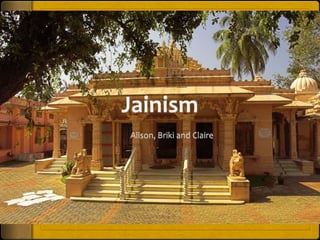
Jainism
- 1. Jainism Alison, Briki and Claire
- 2. Introduction to Jainisim The Universe is eternal, but goes through a cycle continuously. Time consists in 2 periods, ascending (Utsarpinee) and descending (Avasarpini). In each these 2 cycles (which are repeated over and over again), 24 Jinas have come into existence. The first Jina is believed to have appeared about six trillion years ago. The universe has living beings (Jiva) and non-living beings (Ajïva). Karma is based on a Jiva’s interaction with other Jiva and Ajïva.
- 3. The Beginning The history of Jainism can be traced back through 24 Jinas. The first Jina was supposed to be a giant who lived 8.4 million years ago. Recent and last Jina was Vardhamana, who was born 550 BCE.
- 4. Vardhamana Also known as Mahivira. Founder of the Jain community. Attained enlightenment after 13 years of deprivation. Died after committing salekhana in 467 BCE. “Conquered love and hate, pleasure and pain, attachment and aversion, and has thereby freed ‘his’ soul from the karmas obscuring knowledge, perception, truth and ability.
- 5. Basic Beliefs The universe is constructed from many layers, which are heavens and hells. It has no beginning and no ending. Everyone is bound to the universe by karma-the accumulated bad deeds a person has done. The endless cycle of reincarnation is only achieved after having reached enlightenment.
- 6. The Layers of the Universe Supreme abode-where liberated souls live, at the very top of the layers of the universe. Upper world-where celestial beings live, also known as the 30 heavens. Universe space-the cloud layers around the upper world Middle world-consists of the Earth and the rest of the universe Nether world-the 7 hells The Nigoda-where all the lowest forms of life live. (The base of the universe.)
- 7. The 3 Basic Principles, or The 3 Ratnas Right faith Right knowledge Right action
- 8. 5 Principles of Living (Vows) Ahimsa: non violence Satya: Only speak the truth Asteya: Do not steal Brahma-charya: Sexually monogamous Aparigraha: Detach from material things, people, and places.
- 9. Basic Practices A vegetarian diet is followed, to prevent harm to any animal. Sacred texts are often read daily. The 4 stages of life are followed.
- 10. 4 Stages of Life Brahmacharya-ashrama: student life Gruhasth-ashrama: family life Vanaprasth-ashrama: social services and family life Sanyast-ashrama: monk life (a period of renunciation)
- 11. Groups of Jains Shvetambaras-known for monks that wear white robes. Digambaras-known for monks that do not wear anything. Sadhu is a monk. Sadhvi is a nun.
- 12. Cosmology The universe goes through time cycles, called Kalchakra. Each Kalchakra consists of a Utsarpini and an Avsarpini. Each Utsarpini and Avsarapini is divided into 6 periods called Aras. It is believed we are in our 5thAra of the Avarpini period. There are about 18,500 until the next Ara.
- 15. Diffusion Jainism is practiced mainly in India, where there are about 10.2 million followers. Relocation diffusion has occurred, bringing Jainism to North America, Western Europe, East Asia, and Australia.
- 16. Organization of Jainism The 2 sects of Jainism (Digambar and Svetambar) divided 200 years after Mahavira achieved enlightenment. Svetambaras believe the split occurred when the chief monk AcharyaBhadrabahu predicted a 12 year famine, and lead 12,000 Digambar followers to southern India. The followers who remained became the Svetambar sect.
- 17. Differences between Digambar and Svetambar Digmabars believed that women cannot attain enlightenment in the same birth. Svetambars believe women may attain enlightenment, and that Malinath (a Jina, or Tirthankar) was in fact a woman. Digambars also believe that Mahavir was unmarried. Svetambarsbelive that Mahavir married a woman, and had a daughter.
- 18. Impact on the Physical Environment Jainas leave little or no imprint on the broader ecological system and hold an affinity for the ideals of the environmental movement The path to reach the Siddha Locka entails great care in regard to how one lives in relationship to all other living beings that surround one in the earthly realm Thus, they avoid activities associated with violence and follow a vegetarian diet Jainism contains concepts that can lead to the enhancement of core human-earth relations
- 19. The Five VowsIn Relation to the Physical Environment Nonviolence: fosters and attitude of respect for all life forms Truthfulness: a truthful person cannot easily dismiss the suffering caused by uncontrolled waste Not Stealing: reflects on the world’s limited resources and prompt one to think of the needs of future generations Sexual Restraint: minimizes population growth Non possession: gives one pause to think twice before indulging in the acquisition of material goods, one of the root causes of current ecological concern
- 20. The Peaceful Nature of Jainism Jainism is often described as one of the most peaceful religions There have been no wars fought in the name of Jainism Jainism has been a major cultural, philosophical, social and political force since the dawn of civilization in Asia The Jaina tradition has existed in tandem with Hinduism in India since at least 800 BCE Today, the language remains at peace with other world religions